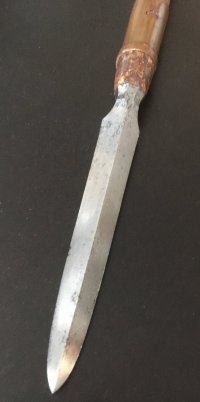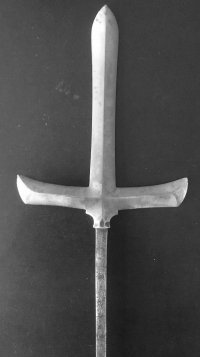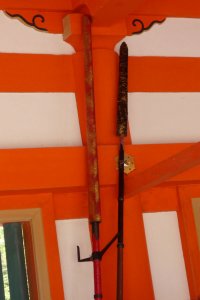There is an incredible number of different types of spears, concerning both the length of the weapon as well as the shape of the blade and how it is mounted. Especially if you include such special forms of spears like uchine or kagoyari which are completely irrelevant for sōjutsu.
Uchine are actually feathered darts on a string, with which they could be withdrawn after they were thrown. There is only one thing they have in common with real spears: the blade, which generally is identical to a triangular suyari blade.
Kagoyari however, often in the style of a jūmonji-kamayari, are very short spears. The name palanquin spear suggests that such spears were used in or out of palanquins. In palanquins however traveled only people who were so high-ranking that they were accompanied by armed escorts, which makes carrying a short spear for self-defense quite superfluous and unlikely. But as weapons for self-defense in cramped spaces like living rooms or bedrooms such short spears seem to have been quite meaningful.
Excluding such special types, spears can be classified according to various criteria. One is the shape of their blade:
 Suguyari have a straight blade. There are hirasankakuyari (flat triangular cross-section), seisankakuyari (equilateral triangular cross-section) and ryōshinogiyari (blade with two ridges, diamond-shaped cross-section) as well as special forms such as sasahozukuri (bulbous blade in the form of a bamboo leaf with flat triangular cross-section) or kamonohashiyari (duckbill spear, squat blade with diamond-shaped cross-section and relatively round tip).
Suguyari have a straight blade. There are hirasankakuyari (flat triangular cross-section), seisankakuyari (equilateral triangular cross-section) and ryōshinogiyari (blade with two ridges, diamond-shaped cross-section) as well as special forms such as sasahozukuri (bulbous blade in the form of a bamboo leaf with flat triangular cross-section) or kamonohashiyari (duckbill spear, squat blade with diamond-shaped cross-section and relatively round tip).
If a spear has one of these straight blades and is not specially mounted, it is called a Suyari (simple spear).
Kikuchiyari, also called tsukushiyari or simply katabayari (single-edged spear), have or are blades in the form of a single-edged tantō blade and, like such a dagger blade, are also mounted with a habaki.
Fukuroyari: Socket-spear. Unlike all other blade forms, the blade of a fukuroyari has no nakago (tang), but a socket. Accordingly it is not mounted in the shaft but over the tip of the shaft. Fukuroyaris robustness is inferior to blades with a nakago but they have the advantage that their shafts are easy to produce and can be replaced by any kind of rod, branch etc. if necessary.
 Kamayari: Sickle-spears have side blades coming off the straight main blade. If there is only one side blade or one of these is significantly longer than the other (as with the famous spear of Katō Kiyomasa) they are called katakamayari. Soears with equally long blades are called jūmonji-kamayari or simply jūmonjiyari (cruciform sickle-spear). The side blades are usually bent slightly upwards towards the tip of the spear, but there are also examples which side blades are straight. A jūmonjiyari with downward curved side blades is called karigata-kamayari. Another special type of jūmonjiyari is the chidori-kamayari the side blades of which are curved upwards but also have a small downward pointing tip. Kamayari blades always have a diamond-shaped cross section. The main blade as well as the side blades.
Kamayari: Sickle-spears have side blades coming off the straight main blade. If there is only one side blade or one of these is significantly longer than the other (as with the famous spear of Katō Kiyomasa) they are called katakamayari. Soears with equally long blades are called jūmonji-kamayari or simply jūmonjiyari (cruciform sickle-spear). The side blades are usually bent slightly upwards towards the tip of the spear, but there are also examples which side blades are straight. A jūmonjiyari with downward curved side blades is called karigata-kamayari. Another special type of jūmonjiyari is the chidori-kamayari the side blades of which are curved upwards but also have a small downward pointing tip. Kamayari blades always have a diamond-shaped cross section. The main blade as well as the side blades.
Ōmiyari1 are spears with, as the name says, large blades or the large blades themselves. All blades longer than 1 shaku (30.3 cm) are called ōmiyari.
A further division can be made according to the total length of a spear:
Nikenyari: A spear 2 ken (364 cm) long. Niken was the standard length for spears, which is why suyari always means a simple straight spear of 364 cm unless otherwise specified.
Kozuyari: Small suyari of 9 shaku (273 cm) length.
Teyari: Handy spear of approx. 210 cm length.
Finally there is the classification according to the type of spear mounting:
Kudayari: Usually a suyari, which is passed and thrust through a metal tube (kuda). Since the leading hand grips the tube and has no direct contact with the spear shaft, the frictional resistance is lower as compared to a normal spear. Therefore, a Kudayari can thrust or vary the distance very quickly.
 Kagiyari1: A spear with a parry bar attached to its shaft. On one side this is usually formed into a hook pointing towards the tip of the spear, sometimes also on both sides. A Kagiyari can be used similarly to a kamayari, but without the need for its special blade.
Kagiyari1: A spear with a parry bar attached to its shaft. On one side this is usually formed into a hook pointing towards the tip of the spear, sometimes also on both sides. A Kagiyari can be used similarly to a kamayari, but without the need for its special blade.
Specific examples of use:
- Hōzōinryū: 9 shaku (273 cm) jūmonji kamayari und 2 ken (364 cm) Suyari
- Fūdenryū: 2 ken (364 cm) suyari
- Ôwari Kanryū: 2 ken (364 cm) kudayari
- Saburiryū: 9 shaku (273 cm) kagiyari1 und 9 Shaku (273 cm) kozuyari
All comprhesive systems known to the author that include sōjutsu use 9 shaku (273 cm) kozuyari.
1. The kagiyari of the Saburiryū is an ōmikagiyari with a blade of 2 shaku (60.6 cm) length. The parry bar is mounted directly behind this enormous blade.
